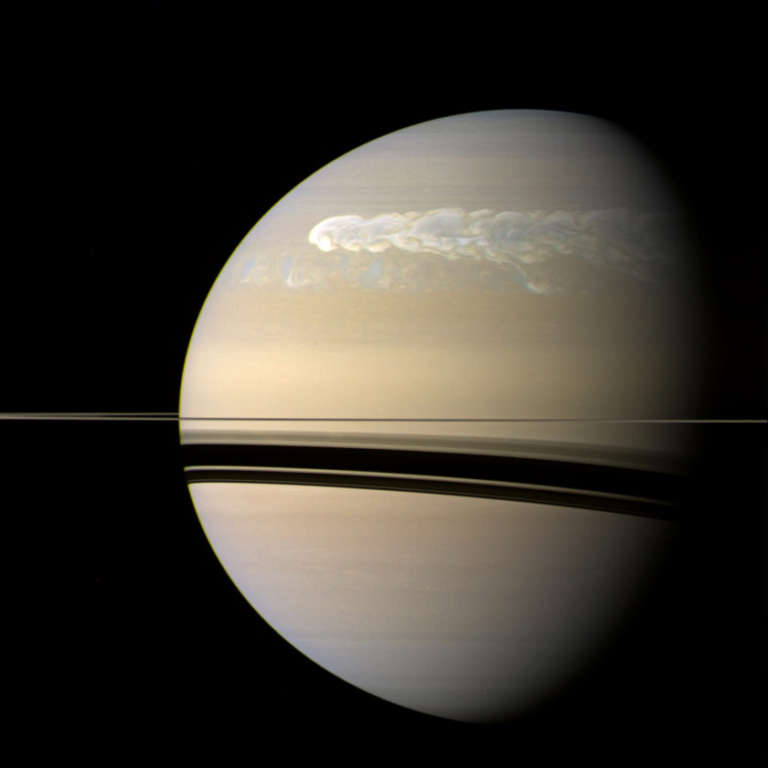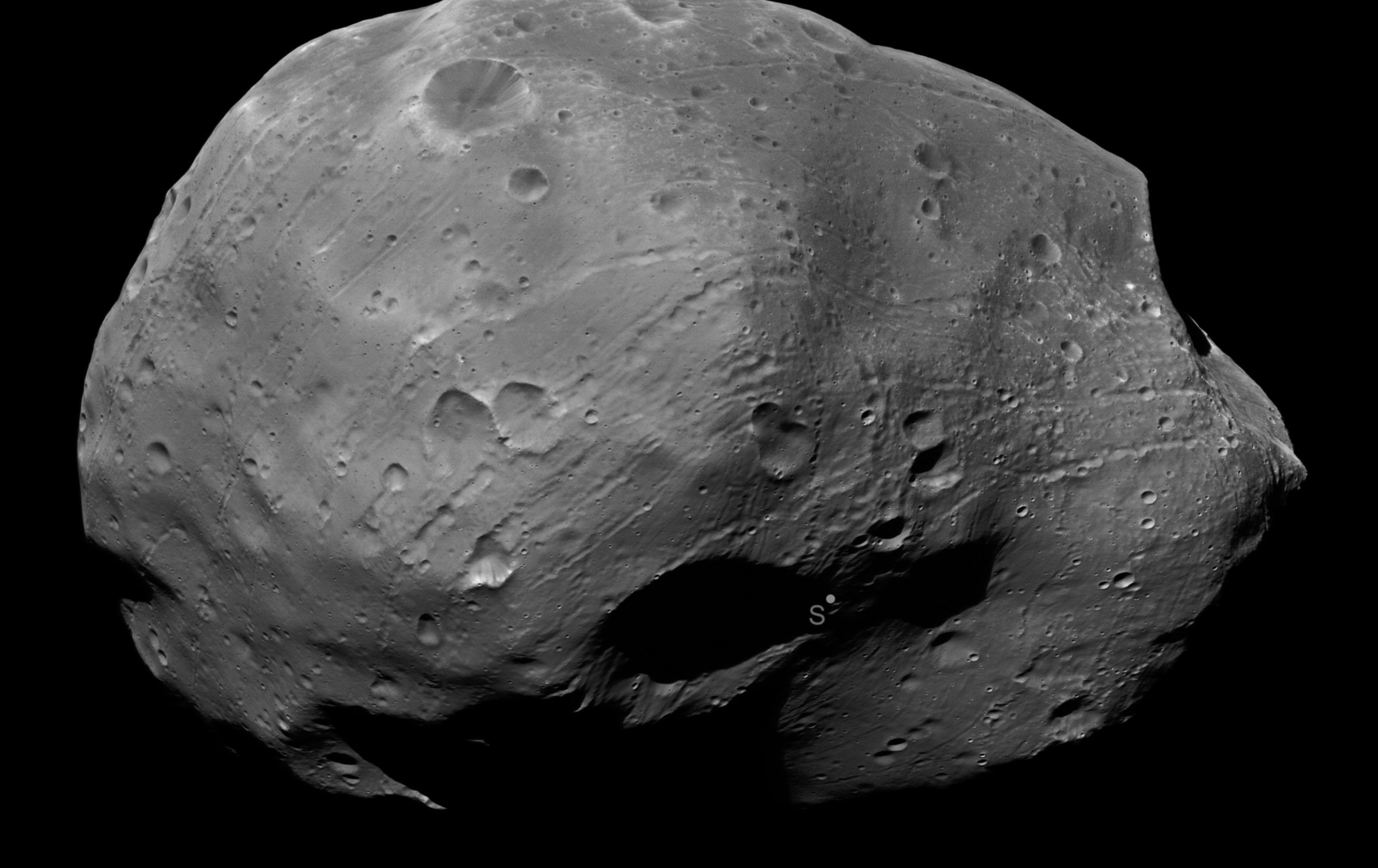Emily Lakdawalla • Oct 07, 2011
Notes from Day 5 of the EPSC/DPS meeting: Saturn's storm, Phobos, and Lutetia
Today was (is) the last day of the Division of Planetary Sciences / European Planetary Science Congress meeting in Nantes, France. Attendance was winding down in part because it's Friday and in part because of a wildcat strike on the French rail network, which has sent many attendees scrambling for alternative transportation back to the Paris airport to catch flights home. This morning I went to talks on outer planet atmospheres; Phobos; and Lutetia. Here are some highlights
I saw several talks on the great storm on Saturn. The storm started up on December 5, 2010 and ended in late August of this year. It was the first lightning storm during the Cassini mission that was located in the northern hemisphere. Saturn's had these storms before -- according to Augustin Sanchez-Lavega, this is the sixth Great White Storm to have been recorded, the first being in 1903 -- and they always occur either near the equator or in the summer hemisphere at around 38 degrees latitude.

The storm was first detected by amateur astronomers, and shortly after through the radio emissions from its lightning, recorded by the Cassini Radio and Plasma Wave Spectrometer. Peak lightning rates were 10 per minute, and the storm's lightning put out as much power as all of Saturn's emission combined.
The storm first blossomed in the middle of the "string of pearls" feature that was first observed by Cassini VIMS some time ago. Like the ambient winds at this latitude, the storm drifted westward at 2.8 degrees of longitude per day; at the same time, its cloud was sheared into a longer and longer eastward-stretching tail. The tail encircled the whole planet after two months. Lightning always existed in the storm "head" but extended into the "tail" region over time, to almost halfway around the planet. The tail developed a persistent dark spot in its central branch that also extended eastward with time. In June of this year, the dark area from the central branch approached the head of the storm. They collided on June 15, after which the head of the storm split into three smaller spots. By the next day, the storm head had become very difficult to track, and now the storm has died out. (One speaker, Sayanagi, summed this up as "Storm bit own tail, died." Yet, beneath the uppermost haze layers, there remains a persistent gap in the clouds at the latitude of the storm, and the string of pearls has not yet returned.
At this point I moved on to the Phobos room for two talks based on the recent campaign by Mars Express to have frequent encounters with the moon. The first talk, by T.P. Andert, concerned its gravity field; the conclusion was that it is likely highly porous, with local density anomalies (that is, in some places it's denser than it is in others, and it's not neatly stratified in density). So it's likely it formed by re-accretion of a disrupted body -- it's a rubble pile.

Then I saw John Murray give a talk on the origin of Phobos' grooves. He outlined a set of observations about the grooves based on hundreds of Mars Express images:
- Each groove traces a plane through Phobos. Even ones that appear irregular actually cut a plane straight through it, if viewed from within the plane.
- There are several (10 or 15) distinct families of parallel grooves.
- For each groove family, the parallel plane passing through the center of Phobos also passes through Phobos' leading apex
- A corollary of this is that all grooves become parallel along sub- and anti-Mars meridians
- Each groove family extends over no more than one half of Phobos, fading out at tips and failing to appear over other half
- At the back end of Phobos, all grooves suddenly end, and there are none within 20 to 30 degrees of the trailing end of Phobos.
- Grooves are interrupted by topography near the edge of their hemisphere
- The grooves are not radial to Stickney crater; they actually cross Stickney both radially and tangentially; there is no geometric relation
- Each family of grooves is of a different age
- All grooves are younger than Stickney
- When viewed from low sun angles, it's evident that all grooves are crater chains and they have raised rims
There is only one origin hypothesis, he argued, that is consistent with all of these observations: that they are secondary impacts, chains of craters, made by strings of melt that solidified into beads from impact craters from Mars. It was a fairly convincing case, and he did well at refuting what is apparently a fashionable interpretation right now, that the grooves represent the tracks of rolling boulders. And just a comment from a stylistic point of view -- where most presenters would have put all these statements in one or two slides in large blocks of text and may not have taken time to review them all, he put each statement on one slide with an illustrative image; it was much more convincing this way.
A few talks on Lutetia: According to M. Pätzold, Despite some challenges with the geometry of the flyby, Rosetta determined Lutetia's mass much more precisely than ever before, and found that previous attempts to determine its mass (from astrometry, using its influence on other asteroids and Mars) systematically overestimated its mass by more than 50%. The actual mass is 1.70 ± 0.017 x 10^18 kg, giving it a density of 3400 ± 300 kg/cubic meter, where the error is dominated by the error in the volume estimate. This is pretty dense, especially if Lutetia has any significant amount of porosity, so it's largely rock with some metal.
According to M. Küppers, the largest craters on both Lutetia and Steins both formed geologically recently, in the last several hundred million years. Based on previous estimates of the size of the asteroid population. Impacts of this size are only expected to occur once every few billion years. It's statistics of small numbers, but there is a commonality of asteroids having large craters at a higher rate than statistics suggest is likely. This implies that there may be more small asteroids (1 to 100 meters in size) than previously thought; this part of the asteroid population is basically unobserved. Bill Bottke said this may be consistent with WISE observations.

I still have various stuff from yesterday and from press briefings to write up -- I'm working on it! But it's likely there will not be another post from me until next Tuesday. I return home tomorrow, and Monday is a U.S. holiday, and I need to catch up with my family -- and catch up on sleep!
Let’s Go Beyond The Horizon
Every success in space exploration is the result of the community of space enthusiasts, like you, who believe it is important. You can help usher in the next great era of space exploration with your gift today.
Donate Today

 Explore Worlds
Explore Worlds Find Life
Find Life Defend Earth
Defend Earth

